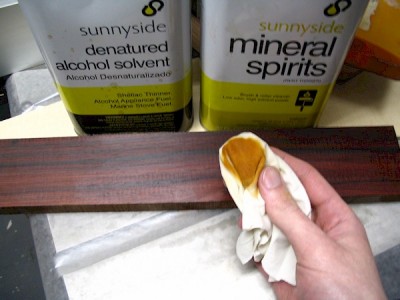1.) WIPE THE WOOD SURFACE WITH A SOLVENT PRIOR TO GLUING.
Since the primary problem that tropical woods present in gluing is their oiliness, (with density probably being the second biggest problem), any of these natural oils and resins that you can remove from the wood surface will help the glue adhere that much better.
While it’s not a cure-all, wiping the wood with a solvent first goes a long way. But you have to be sure of two things: first, you should try to glue the pieces of wood to be joined as soon as possible after the solvent has evaporated from the wood surface. This is because the wood’s oils will tend to migrate back to the surface of the wood where you removed some of the oils. Secondly, you have to be sure that the solvent you’re using is actually dissolving and removing the wood’s oils. A good way to gauge this is by checking the towel that you’re using to wipe the solvent to see if it’s changed to the wood’s color.

A solvent should lift surface oils from the wood.
| Note in the example above, mineral spirits was used to lift some of Cocobolo’s oils off the wood surface: and you can clearly see the stained orange cloth as evidence. If you’re initially testing a solvent, make sure that the wood is clear of any small particles of sawdust that might make it appear as though the towel is being discolored. Try a cloth with water first as a baseline: it should basically stay white since the water does not dissolve the wood’s heartwood extractives. Some common solvents that you can try are: acetone, denatured alcohol, lacquer thinner, mineral spirits, and naphtha. |

